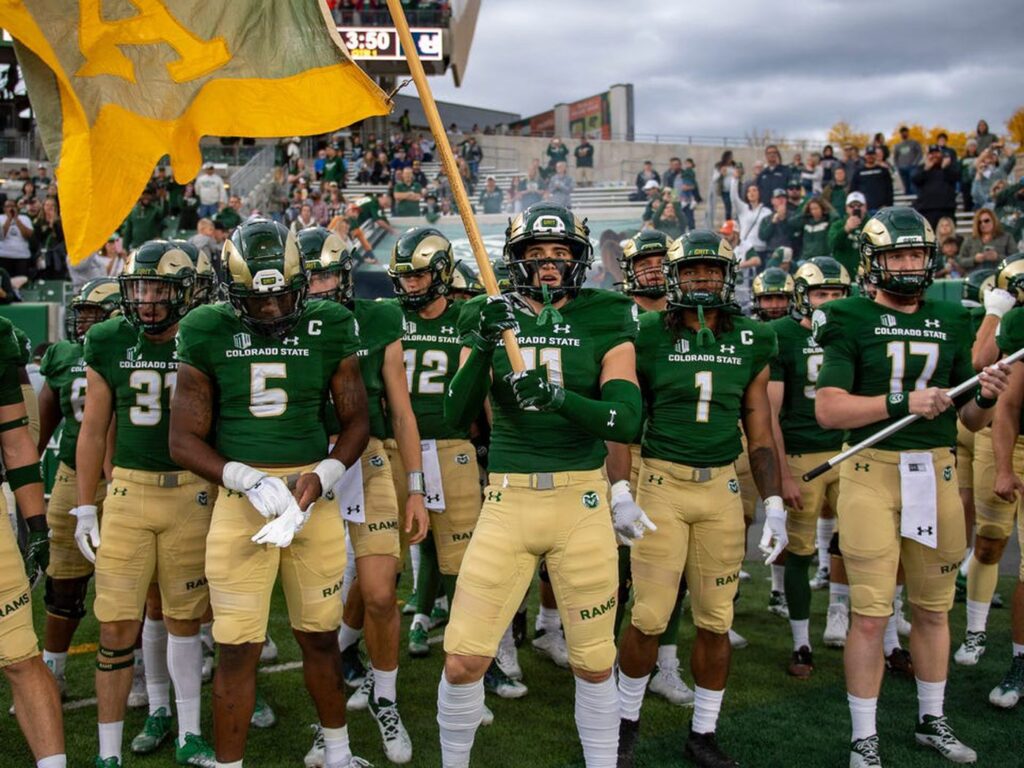Team History
The Colorado State Rams football team’s history is a tale of resilience and evolution, marking its journey from a fledgling squad to a recognized force in college football. Initially competing without a head coach and facing temporary disbandment in the 1890s, the team’s reinstatement in 1899 under coach W.J. Forbes laid the groundwork for its future. This period was pivotal, not just for establishing a coaching framework but also for initiating the storied rivalry with Wyoming following a controversial game that ended in a brawl and a forfeit, reflecting the intense passion and competitiveness that would come to define Rams football.
Following these tumultuous early years, the Rams found stability and success under the guidance of Harry Hughes, who served as head coach from 1911 to 1941 and again in 1946. Hughes transformed the program, leading the team to eight conference championships and earning national acclaim for his coaching philosophy and innovation. His contributions extended beyond the gridiron, playing a key role in the development of Colorado Field, the team’s home until 1968. The era under Hughes is celebrated for setting high standards in sportsmanship and performance, laying a solid foundation for the program’s future successes.
Foundation and Early Years
The foundation of the Colorado State Rams can be traced back to the late 19th century, reflecting the university’s commitment to establishing a competitive athletic program. The early years were marked by challenges, including the brief disbandment of the team and the tragic death of its first official head coach, W.J. Forbes. Despite these setbacks, the appointment of Forbes and his successors in the early 1900s signified the university’s dedication to its football program. This era was characterized by a determination to overcome obstacles and build a team that could compete with the best, setting the stage for future achievements.
The introduction of Harry Hughes as head coach in 1911 heralded a new era of success and stability for the Rams. Hughes’ tenure was transformative, turning a winless team into conference champions and laying the groundwork for the team’s long-term success. Under his leadership, the Rams enjoyed significant achievements, including multiple conference championships and a reputation for sportsmanship and innovation on the field. Hughes’ influence extended beyond his coaching duties, contributing to the development of the team’s facilities and establishing a legacy that would influence the program for decades to come.
Notable Early Achievements
Under the leadership of Harry Hughes, the Colorado State Rams football team achieved notable success, including multiple conference championships and the development of innovative football strategies. Hughes’ era is particularly remembered for the introduction of the “Million Dollar Play,” a testament to his strategic genius and his ability to adapt and innovate within the sport. His teams’ performances during this time not only brought national attention to the program but also set new standards for excellence and competitiveness in college football.
Hughes’ dedication to the sport and his players was evident in his commitment to breaking the color barrier in modern Colorado football, a significant achievement in the context of the times. By playing John Mosley between 1939 and 1942, Hughes demonstrated a forward-thinking approach to inclusivity and leadership. This period of notable achievements under Hughes’ guidance laid a solid foundation for the Rams, influencing the program’s culture and values and establishing a legacy of excellence and innovation in college football.
Periods of Change
The Rams’ football program has undergone numerous periods of change, particularly evident in the transitions between head coaches and shifts in the team’s strategic approaches. Following the Hughes era, the team experienced fluctuations in performance, with coaches like Bob Davis and Don Mullison leading the Rams through varying degrees of success. These periods were marked by efforts to adapt to the evolving landscape of college football, with each coach bringing new strategies and perspectives to the program. The introduction of the “T” formation by Bob Davis, for example, represents the continuous search for competitive advantage and innovation within the team’s playstyle.
The transition from Colorado Agricultural College to Colorado State University marked a significant change in the institution’s identity, including its athletic programs. This period saw the adoption of the Rams mascot and the shift from Aggies to Rams, symbolizing a new era for the football team and the university at large. The changes in management and coaching philosophies during these times reflect the dynamic nature of college football and the program’s resilience in facing challenges and embracing new opportunities for growth and success.
Championships and Achievements
The Colorado State Rams football program has a proud history of championships and achievements, highlighted by conference titles and memorable bowl game appearances. These successes are a testament to the talent and dedication of the players and coaching staff who have represented the university over the years. The team’s ability to compete at a high level and achieve significant milestones has contributed to its reputation as a formidable force in college football. The achievements of the Rams are not only a reflection of individual excellence but also of the collective effort and spirit of the team and its supporters.
Significant achievements such as conference championships and noteworthy performances in bowl games have cemented the Rams’s place in college sports lore. Their resilience in overcoming challenges and periods of change has shaped a program that prides itself on tradition, spirit, and continuous pursuit of excellence. These moments of triumph are celebrated by fans and alumni alike, serving as milestones that underscore the team’s historical significance and its role in fostering a vibrant sporting culture at Colorado State University.
Current Roster
The current roster of the Colorado State Rams football team represents a blend of seasoned players and promising new talent, each bringing their unique skills and determination to the field. This mix is crucial for the team’s performance in the highly competitive Mountain West Conference. The roster is carefully selected by the coaching staff, aiming to build a cohesive unit that can execute the team’s strategic vision and compete at the highest levels. Players on the current roster are expected to uphold the program’s values of hard work, teamwork, and sportsmanship, contributing to the ongoing legacy of Rams football.
Management and Coaching Staff
The management and coaching staff of the Colorado State Rams play a pivotal role in shaping the direction and success of the football program. Through strategic recruitment, player development, and game planning, the coaching staff works tirelessly to maintain the team’s competitive edge. Leadership from the coaching staff is crucial, not only in developing athletes’ skills on the field but also in instilling the discipline, integrity, and determination needed to excel in both sports and academics. The evolution of the coaching staff over the years reflects the program’s adaptability and commitment to excellence, with each new appointment bringing fresh perspectives and strategies to the team.
Home Stadium Information
The home stadium of the Colorado State Rams is not just a venue for football games; it’s a symbol of the team’s history and the community’s support. Originally playing at Colorado Field, the Rams enjoyed significant home-field advantages, which contributed to the team’s early successes. The construction of Hughes Stadium in 1968, named in honor of legendary coach Harry Hughes, marked a new chapter in the program’s history, providing a modern facility for the team and its fans. The stadium has since been a fortress for the Rams, hosting numerous memorable games and serving as a gathering place for fans to celebrate their team’s achievements and heritage.
-
*********** ***** ******* *** ***** ** ************ **** ********* *****dd.mm.yyyy 00:00 PM
-
****** *********** **** ** ***** ****** *** **** *** ******: ********* *** ******* *** ****'* ****dd.mm.yyyy 00:00 PM
-
*********-***** ********: **** 6 **** *** ***** *** * ********* **** 7dd.mm.yyyy 00:00 PM
-
**********-************ *******: ****** ****ć, ******* *******, *** * ********* ********** ********dd.mm.yyyy 00:00 PM
-
********* **** ********* ** *** ***: ********* *** ********* ** ****** ******** **. *** *** *****dd.mm.yyyy 00:00 PM
-
****************** ******* **********: *** ********' **** ****dd.mm.yyyy 00:00 PM







